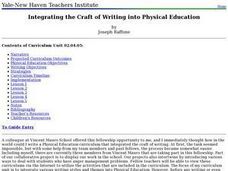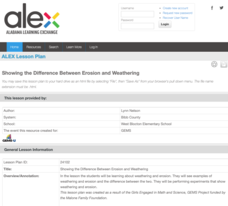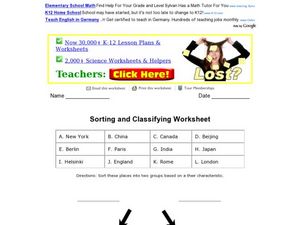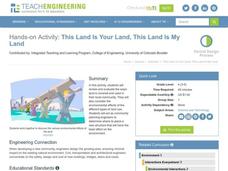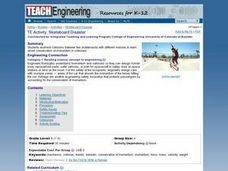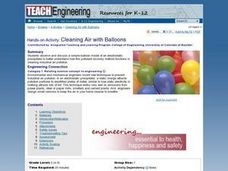Curated OER
Children's Literature Across the Curriculum Ideas-The Christmas Miracle of Jonathan Toomey
Young scholars read The Christmas Miracle of Jonathan Toomey by Susan Wojacieckowski. They complete a variety of cross-curricular activities surrounding the Christmas holiday. Included are reading, art, math, science, writing, social...
Alabama Learning Exchange
Are Your Numbers Round?
Elementary schoolers investigate how to round numbers to the nearest tenth. In this number sense lesson, learners view a video clip on the Internet to practice rounding numbers. They use place value charts to help aid in the rounding...
Curated OER
Integrating the Craft of Writing into Physical Education
Incorporate writing into your physical education class. In groups, learners unscramble a list of words related to exercise and use them in their journal writings. Using their name, they write one word related to physical activity that...
Curated OER
When I Was Young In Appalachia
Young scholars comapre and contrast the lifestyles of the people of the Applachian region with their own community through in-class discussions, creative projects, hands-on activities, food preservation, homemade remedies, home...
Alabama Learning Exchange
Showing the Difference between Erosion and Weathering
Learners explore the concepts of weathering and erosion. After viewing pictures of both erosion and weathering, young scholars work in pairs to conduct an experiment with sugar cubes, water, sand, and a straw. They write their...
Curated OER
I'm Not In Range
Students discover how cell phone service works while participating in a role play activity. They identify its advantages and disadvantages based on service. They examine how engineers use this information to develop better...
Curated OER
Cartography
Students research about cartography and how to be a cartographer. In this math activity, students draw a map of their classroom. They use a robot to explore navigation using a compass rose.
Curated OER
Locating the Salt Front
Students use Hudson River salinity data to create a line
graph that shows the location of the salt front, and use math
skills to explore how this location varies over time. They use the graph to estimate the location of the salt front...
Curated OER
Sorting and Classifying Places
In this sorting and classifying worksheet, students sort a group of places into 2 groups based on a chosen characteristic. Worksheet contains a link for additional activities.
Curated OER
Environment Maze
In this environment worksheet, students "guide the tree to the forest," completing a maze. Worksheet contains a link to additional activities.
Curated OER
Simple Machines-Creative Group Writing
In this creative writing worksheet, students work with a group, using words in a word bank to write a brief story about simple machines. Worksheet contains a link to additional activities.
Curated OER
Aqua-Thrusters!
Students construct their own rocket-powered boat called an "aqua-thruster." These aqua-thrusters will be made from a film canister and will use carbon dioxide gas - produced from a chemical reaction between an antacid tablet and water -...
Curated OER
Divisibility Rules Using Scientific Calculators
Young learners apply divisibility rules to determine if a number is a factor of another number. They discuss what numbers are factors of another number and identify patterns using divisibility rules.
Curated OER
Design a Recycling Game!
Students discover that recycling is using a product more than once so that natural resources can be saved and so that we won't need so many garbage dumps and landfills. They see that there are different ways to recycle. Students design a...
Curated OER
Tornado!: Types and Formation
Students discuss the different types of tornadoes and how they form. Working in groups, they record journal entries by conducting experiments with water bottles simulating vortex formation.
Curated OER
Build an Approximate Scale Model of an Object
Students create a model of an object of their choice using sketches that they have drawn. They study what a scale model is and how to construct one. They examine the uses for scale models and why they are produced.
Curated OER
This Land Is Your Land, This Land Is My Land
Students review and evaluate the ways land is covered and used in their local community. They consider the environmental effects of the different types of land use. Students act as community planning engineers to determine where to place...
Curated OER
Egyptian Hireroglyphs
Fifth graders identify the aspects of Ancient Egyptians and Heiroglyphs. They compare and contrast Egyptian Hieroglyphs with the decimal number system. Students recognize the decimal number system and compares to bases other than ten.
Curated OER
Skateboard Disaster
Learners conduct a hands-on experiment with collisions between two skateboards of different masses. They are introduced to the concept of conservation of momentum in collisions and consider how their observations might help engineers...
Curated OER
Cleaning Air with Balloons
Students examine how a pollutant recovery method functions in cleaning industrial air pollution. They listen to a teacher-led discussion, conduct an experiment with balloons, static electricity, and pepper, and observe and record the...
Curated OER
Dripping Wet or Dry as a Bone?
Students use a sponge and water model to explore the concept of relative humidity and create a percent scale. They define humidity and saturation, build a simple humidity/saturation model, collect, predict and interpret data, and create...
Curated OER
I Feel Renewed!
Students participate in a simulation of the equal and unequal distribution of the earth's renewable resources. They discuss renewable resources and how food resources can increase and decrease, participate in the simulation, and analyze...
Curated OER
Kidney Filtering
Students investigate how kidneys function. They discuss how a dialysis machine works, and conduct an experiment in which they filter different substances through a plastic window screen, various sizes of hardware cloth, and poultry...
Curated OER
Swing in Time
Young scholars examine the motion of pendulums and come to understand that the longer the string of the pendulum, the fewer the number of swings in a given time interval. They see that changing the weight on the pendulum does not have an...


